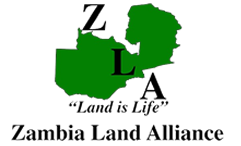Home > About Us
Zambia Land Alliance was established in 1997 as a response to the Zambian government’s land reform process, which was initiated in the 1990s. Zambia Land Alliance is a network of NGOs promoting fair land policies, laws and land administration, which take into account the needs of the poor. ZLA’s mission is to be a platform for collective action committed to promoting equitable access and secured ownership of land by the rural poor, through lobbying and advocacy, networking, research and community partnership. ZLA is a membership organization, and operates through a National Secretariat, national member organizations, district Branches[1] and project offices.
[1] Also Known as District Land Alliances
Zambia Land Alliance recognizes that land is a critical resource for human survival in terms of social and economic development. Most importantly, land is the major source of people’s livelihoods, which must be used wisely for sustained social and economic returns. As such, there is a wide recognition that access, control and ownership of land constitutes one of the most effective ways of empowering communities to sustain their livelihoods. It has also been noted that when people have a sense of ownership of their land, they will be able to take good care of the land and its associated natural resources. However, the majority of Zambians does not enjoy land tenure security and face various challenges including inadequate and unenforced legal and policy provisions, low levels of participation and transparency in land administration as well as negative cultural traditions.
Zambia Land Alliance was able to reduce of the cost of activity implementation through collaboration with other organisations and building the capacity of community members to support others such as CLACs and Saving group Masters Trainers. The efficiency and sustainability of the ZLA activities were also enhanced through the formation and support of community structures such as saving groups, Study Circles and Community Based Natural Resource Management Committees (CBNRMCs). In particular, the following noted results were noted:
By June 2021, 4943 females and 11353 male customary land holders had received CLHCs from their chiefs. Chisamba, Gwembe, Lufwanyama, Monze, Nyimba and Solwezi.

Zambia Land Alliance is a platform for collective action committed to promoting equitable access, control and secured ownership of land by the rural, peri-urban and urban poor and marginalized, through lobbying and advocacy, networking, research and community partnership
Duis aute irure dolor in repre henderit in voluptat
2024 Zambia Land Alliance - Land is Life. All rights reserved.